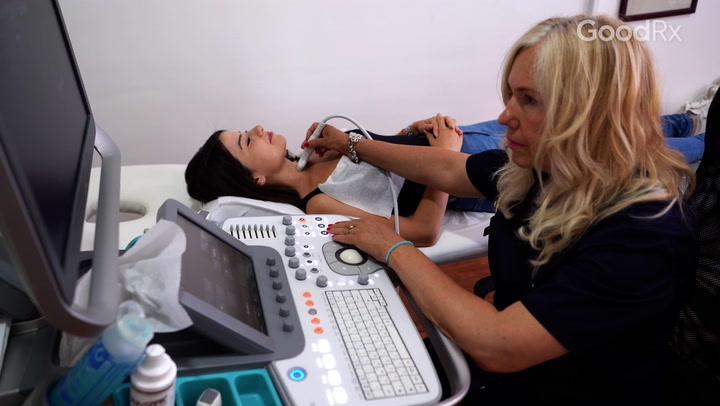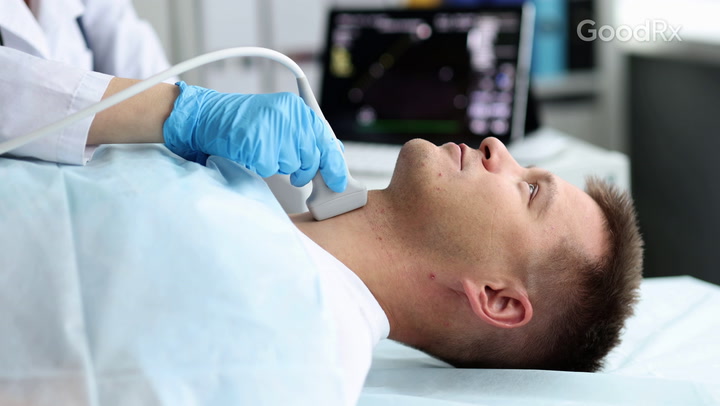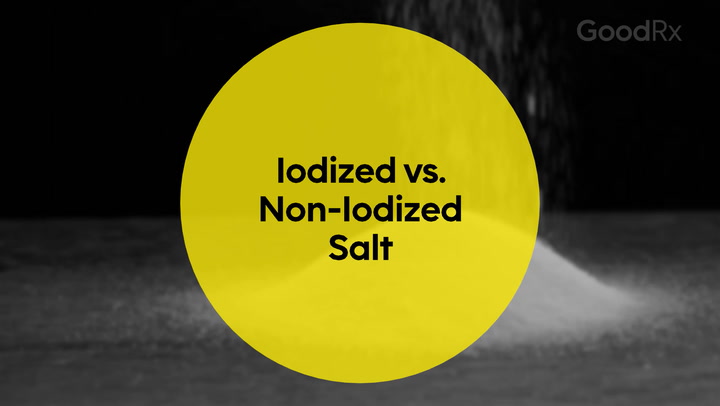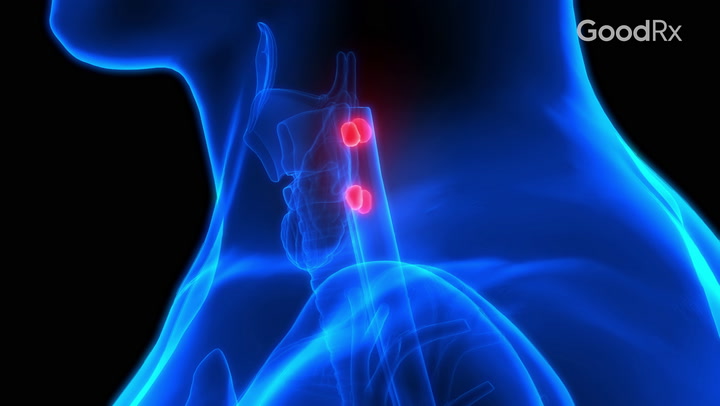
Thyroidectomy: How It Works and When You Might Need One
Key takeaways:
Thyroidectomy is a common and safe surgical procedure to partially or completely remove the thyroid gland.
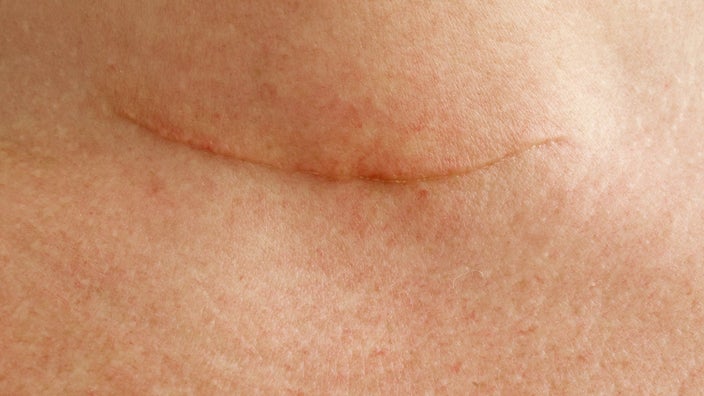
An abnormal growth is the most common reason for having a thyroidectomy. This may be from nodules, a goiter, or thyroid cancer.
You may need to follow up regularly after a thyroidectomy. This can include regular lab tests and prescription medication.
The thyroid is a small gland at the base of your neck. It sits just in front of the trachea (windpipe). The thyroid gland makes hormones that work on every tissue in the body. It helps keep your temperature, heart rate, and metabolism in a safe range. It’s also important for bone, brain, gut, and muscle health.
Save over 70% on Cytomel
Feel your best with Cytomel, a common thyroid medication. Pay as little as $35.10 for 90 tablets of Cytomel with GoodRx - no insurance needed.

But sometimes the thyroid becomes enlarged or doesn’t function properly, and it needs to come out. Thyroid removal (thyroidectomy) is a surgery that removes the whole gland or just a part of it. There are several different types of thyroidectomy. Your healthcare provider will help you decide which procedure is right for you.
When is a thyroidectomy necessary?
Thyroidectomy is a very common surgery. In the U.S., surgeons perform more than 100,000 thyroidectomies every year. Your healthcare provider might recommend a thyroidectomy for a number of reasons, including:
Thyroid nodules: These are solid or fluid-filled lumps in the thyroid gland. Nodules are very common and usually are not cancerous. You’re more likely to get thyroid nodules as you get older.
Goiter: A goiter is an enlargement of the thyroid gland. It can become so large that you have trouble breathing or swallowing. With a goiter, your thyroid hormone levels may or may not be abnormal.
Thyroid cancer: Thyroid cancer happens when the cells of the thyroid grow out of control. You may have swollen lymph nodes, a hoarse voice, trouble swallowing, or no symptoms at all. Treatment depends on the type of cancer and how advanced it is.
Hyperthyroidism: Hyperthyroidism is an overactive thyroid. This happens when the thyroid gland makes too much thyroid hormone. You may notice weight loss, accelerated heart rate, sweatiness, or anxiety. You may need surgery depending on the cause of your hyperthyroidism.
What are the different types of thyroidectomy?
There are different surgical procedures for a thyroidectomy. Your provider will decide which surgery is best based on your health condition. Surgery types include:
Open thyroid biopsy: This surgery involves making a small cut in the neck and removing part of the thyroid. Open biopsies are not common because there are less invasive options.
Hemi-thyroidectomy (thyroid lobectomy): A surgeon completely removes either the left or right half of the thyroid. This procedure is common for small cancers or nodules that are only on one side (lobe) of the thyroid gland.
Isthmusectomy: The isthmus is the small piece of tissue that connects the left and right sides of your thyroid. If there’s a small tumor or nodule in the isthmus, a surgeon can remove that piece. This procedure leaves both the lobes of the thyroid in place and working like usual.
Total or near-total thyroidectomy: This is a more complex surgery that removes most or all of the thyroid. It's for larger or aggressive cancers and sometimes for goiter or hyperthyroidism. Recovery time may be longer, and there might be more complications.
Read more like this
Explore these related articles, suggested for readers like you.
What happens when you get your thyroid removed?
When you have all or most of your thyroid removed, you no longer make normal amounts of thyroid hormone. If you don't replace these hormones, you'll develop symptoms of hypothyroidism (underactive thyroid). These symptoms may include:
Weight gain
Cold intolerance
Dry skin
Constipation
Irregular periods
Muscle aches
Depression
These symptoms usually go away with thyroid hormone replacement. If you have a smaller piece of your thyroid removed, there’s an 80% chance you won't need any thyroid medication.
What are the most common complications of a thyroidectomy?
Thyroidectomy is a very safe procedure when a well-trained surgeon does it. You’re more likely to have problems if your tumor or goiter is very large or if you’ve had thyroid surgery before.
Some of the most common complications include:
Bleeding: Bleeding may happen with any surgery. But bleeding in the neck can block the windpipe and result in breathing problems.
Hoarseness: Damage to the nerve(s) of the voicebox can occur during surgery. Sometimes the hoarseness is permanent.
Difficulty breathing: Significant bleeding or nerve damage can cause severe breathing trouble.
Damage to the parathyroid glands: These small glands are attached to the thyroid and help regulate calcium levels. If damaged, you can have low calcium in the blood (hypocalcemia). This can cause tingling, muscle spasms, or seizures.
How long does it take to recover from a thyroidectomy?
Recovery from thyroidectomy is usually quick. Your surgeon will likely tell you to take it easy for 1 to 2 days to reduce the risk of bleeding. Most people can do light activities the day after surgery. You should be able to resume full activities within 2 weeks.
If you had most or all of your thyroid gland removed, you’ll likely experience hypothyroidism. This means your thyroid hormone is too low. You'll need regular blood tests to make sure your thyroid hormone level stays in a healthy range.
If you have a low thyroid hormone level, your provider will talk with you about medications (like levothyroxine) to replace your thyroid hormone. After some adjustments to get the hormone level just right, most people do well.
Are there any alternatives to a thyroidectomy?
Thyroidectomy is the treatment of choice when your provider suspects or confirms cancer. If there’s no possibility of cancer, there are some alternatives to thyroidectomy.
There’s no need to remove simple nodules or goiters that don’t cause symptoms. If there’s no breathing or swallowing trouble, your provider may watch them over time. Radioactive iodine can sometimes treat goiters that cause problems. This can help decrease the size and treat an overactive thyroid.
If you choose not to have your thyroid removed, nodules and goiters need regular monitoring. This is to make sure they remain free of cancer.
The bottom line
Thyroidectomy is a common and safe surgery. The type of surgery that’s best for you depends on whether you have cancer or a goiter as well as the location and size of the nodule. Complications are rare, and most people return to normal activities within 2 weeks. Unless there’s a thyroid cancer, thyroidectomy isn't always necessary. Talk with your healthcare provider about your treatment options.
Why trust our experts?


References
American Cancer Society. (2019). What is thyroid cancer?
American Thyroid Association. (n.d.). Goiter.
American Thyroid Association. (n.d.). Thyroid surgery.
Biello, A., et al. (2022). Thyroidectomy. StatPearls.
Endocrine Society. (2022). Thyroid nodules.
InformedHealth.org. (2018). How does the thyroid gland work? Institute for Quality and Efficiency in Health Care.
Knobel, M. (2016). Which is the ideal treatment for benign diffuse and multinodular non-toxic goiters? Frontiers in Endocrinology.
Lewis III, J. L., et al. (2021). Overview of calcium's role in the body. Merck Manual.
Lofrese, J. J., et al. (2021). Physiology, parathyroid. StatPearls.
National Institute of Diabetes and Digestive and Kidney Diseases. (2021). Hyperthyroidism (overactive thyroid).
Patel, K., et al. (2020). The American Association of Endocrine Surgeons Guidelines for the definitive surgical management of thyroid disease in adults. Annals of Surgery.













